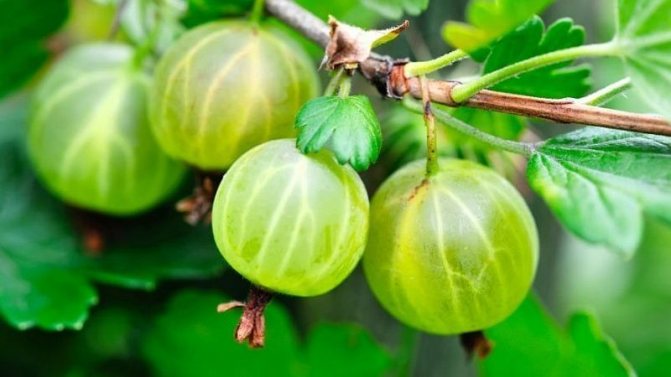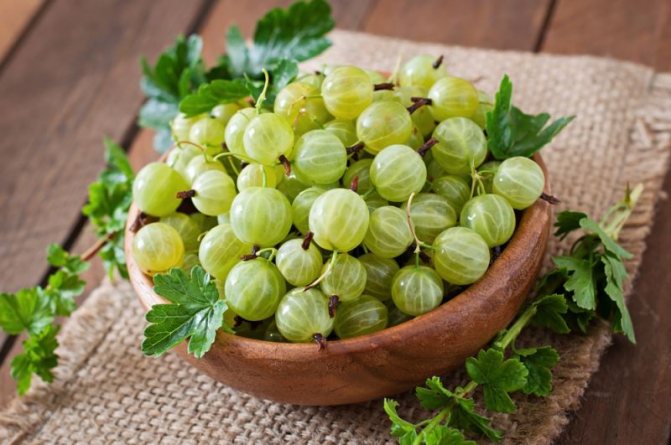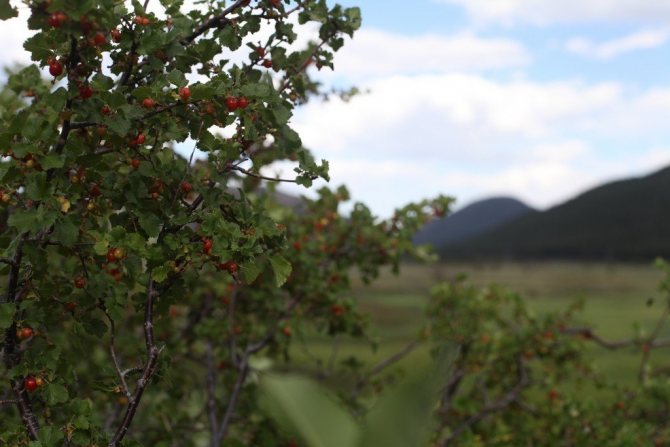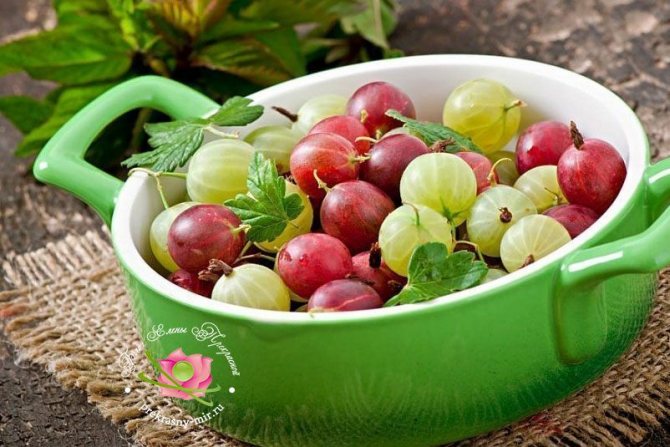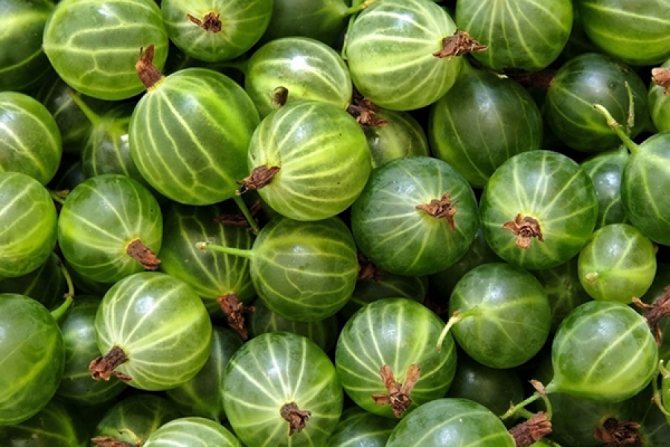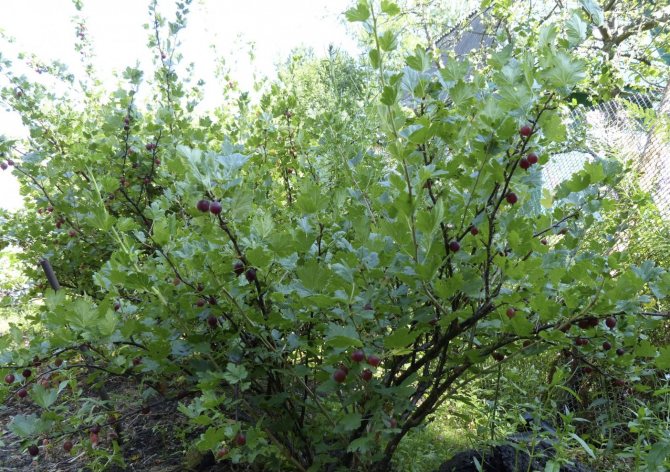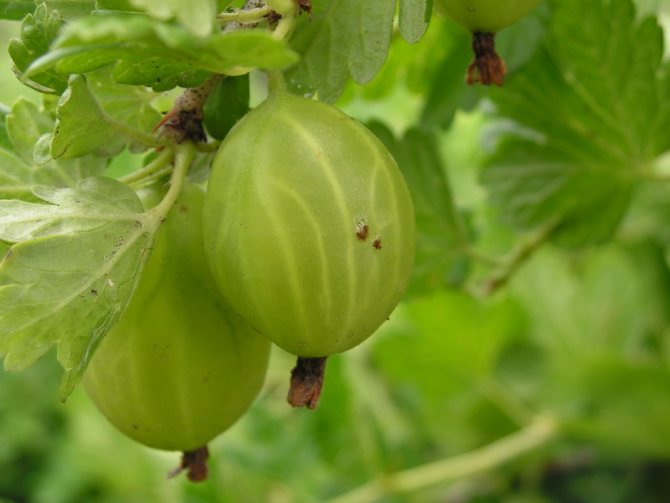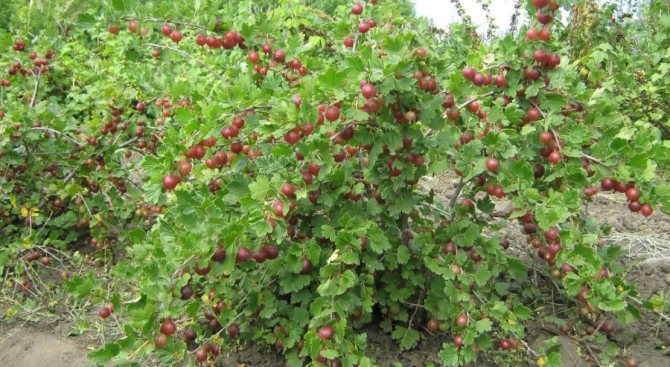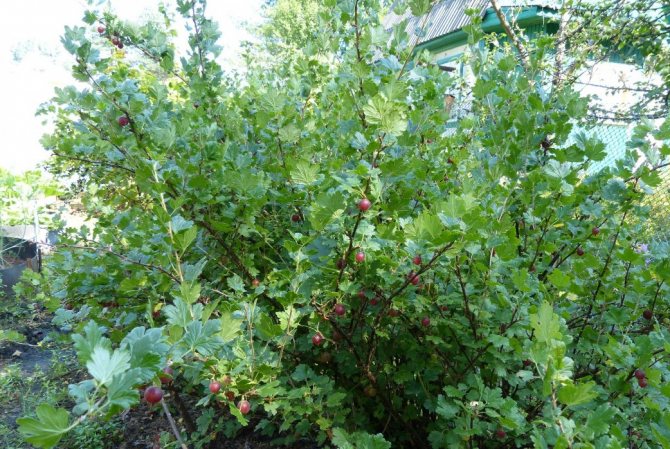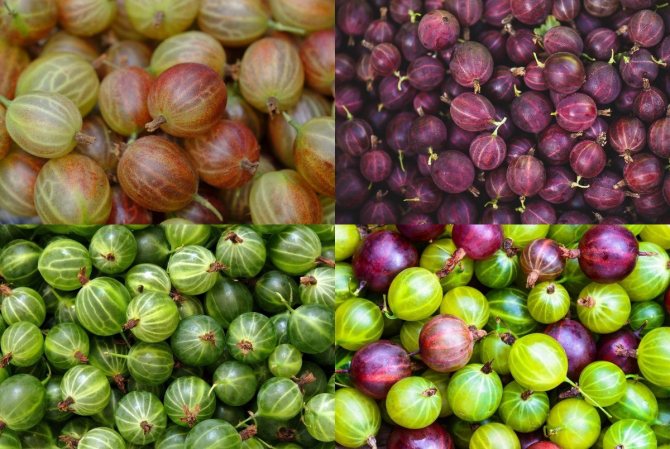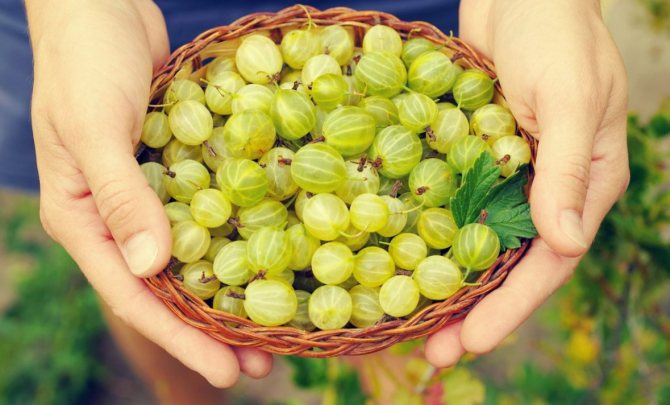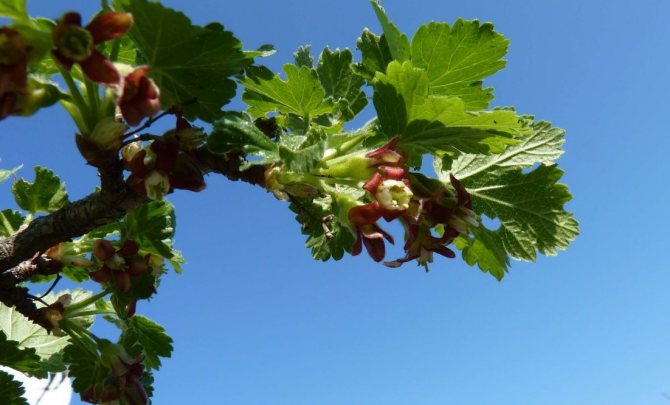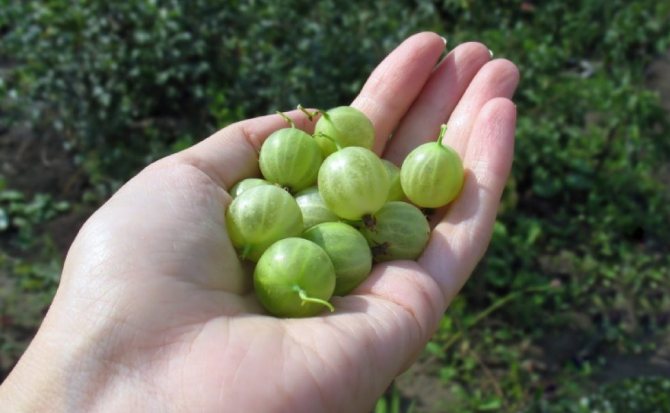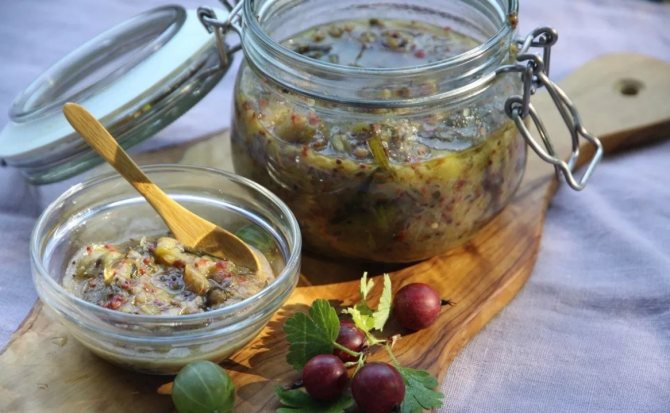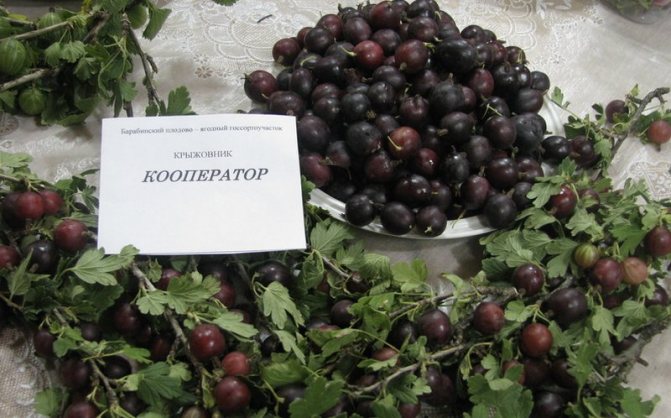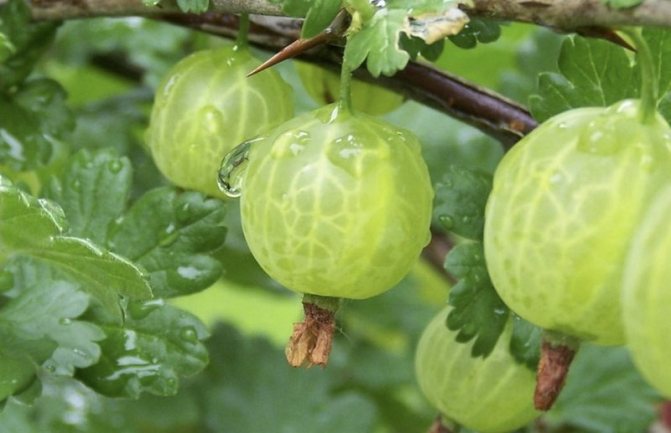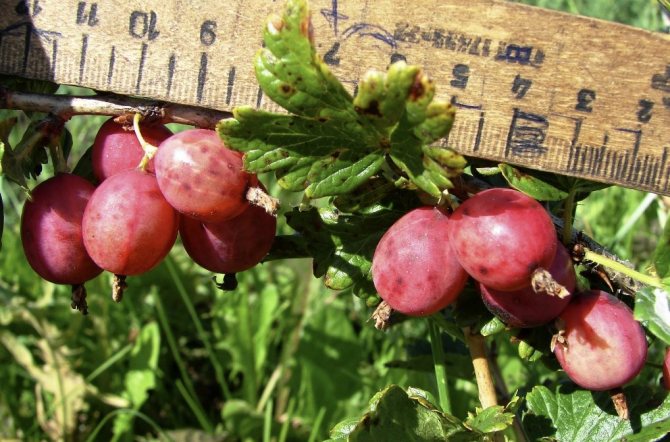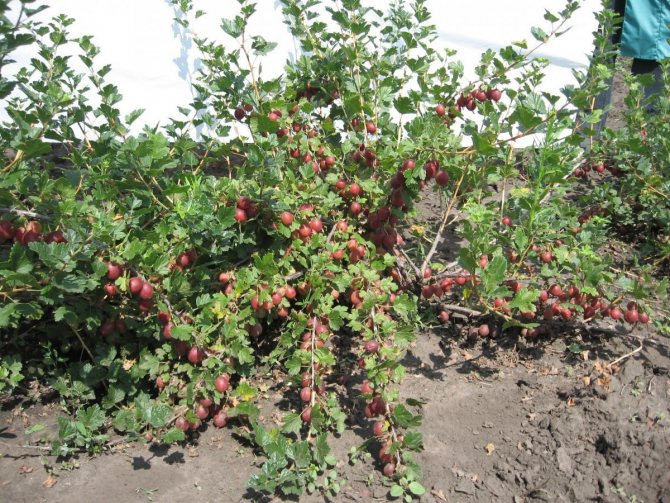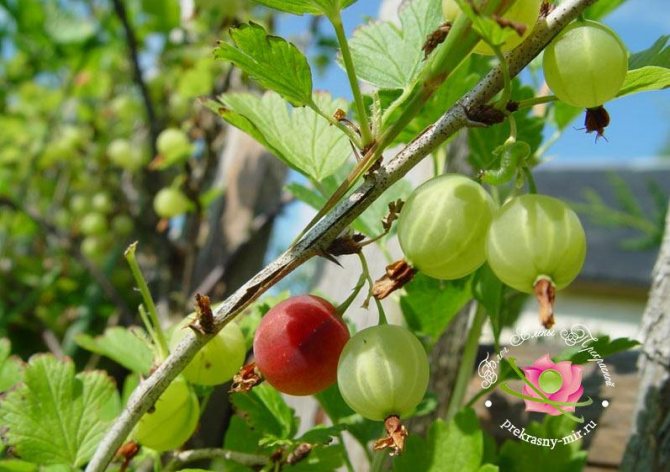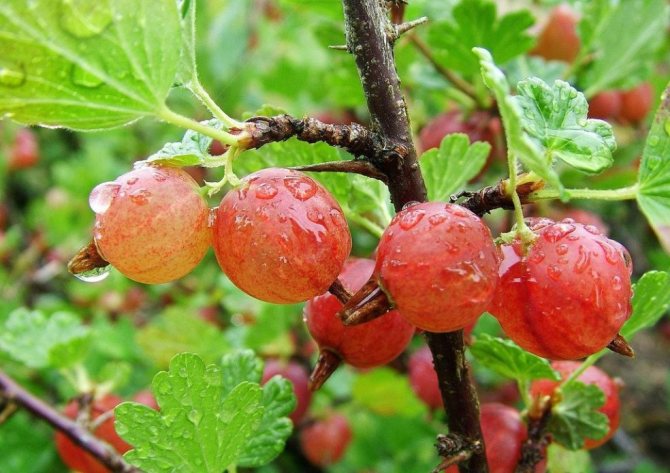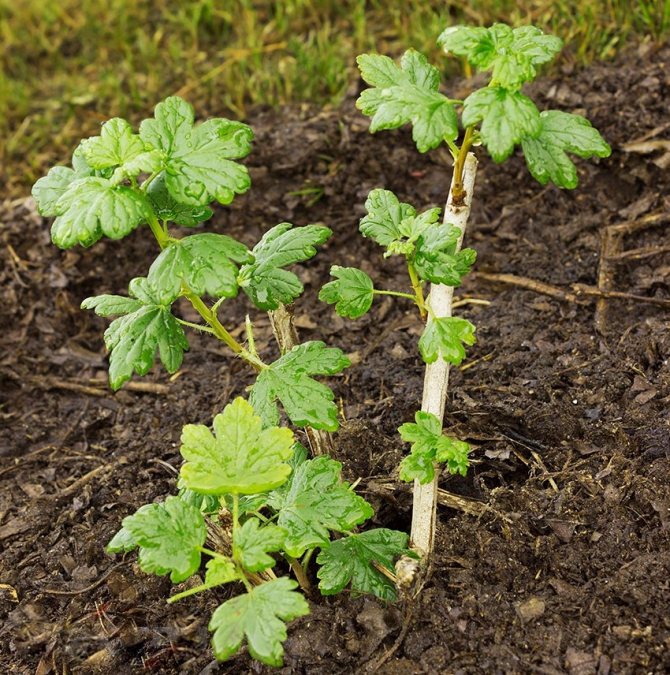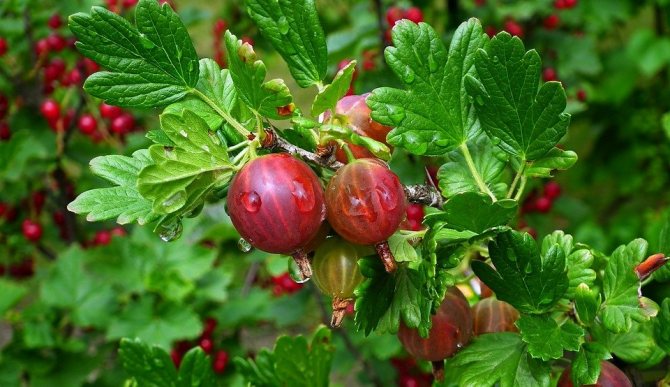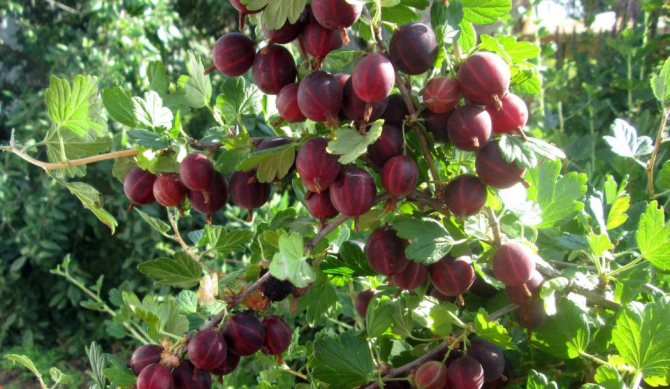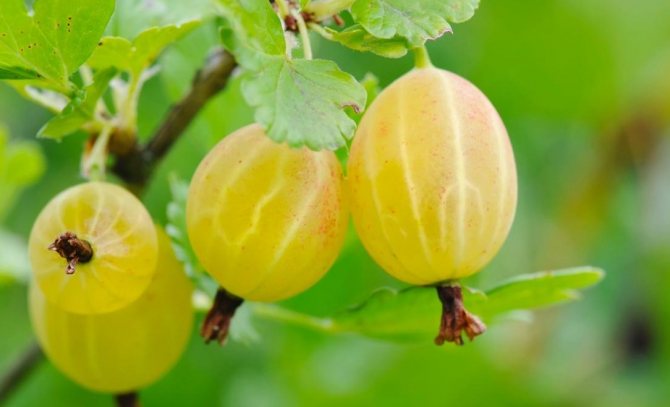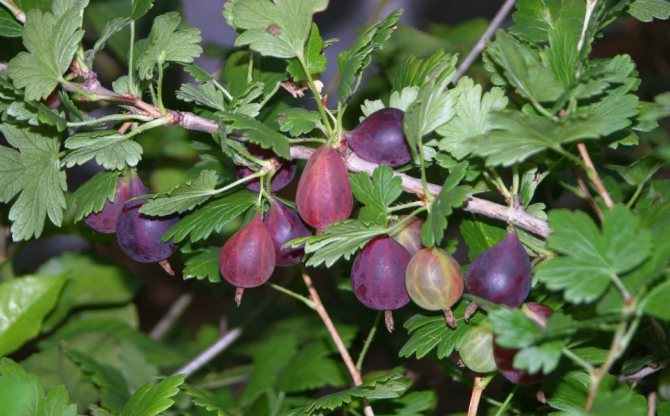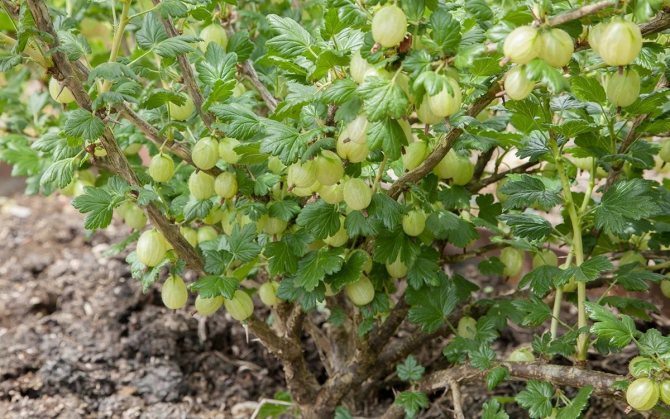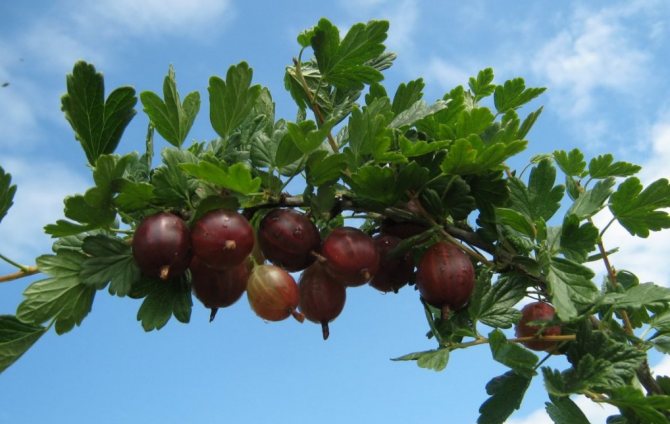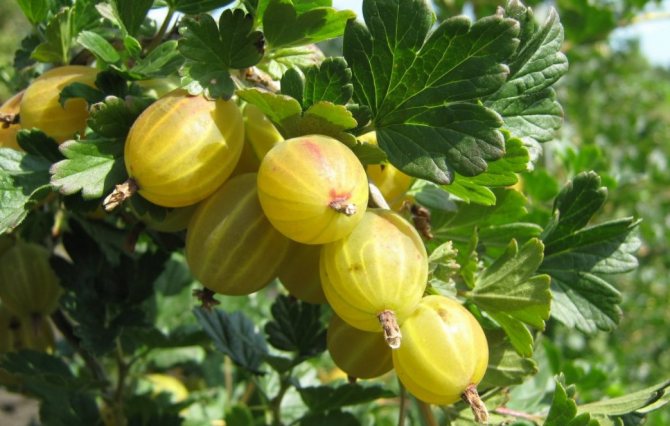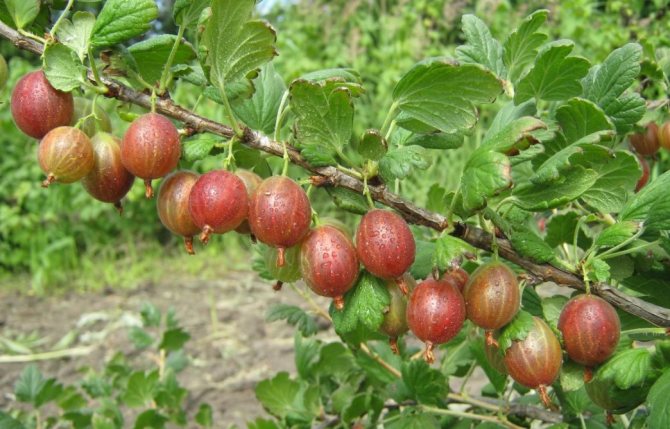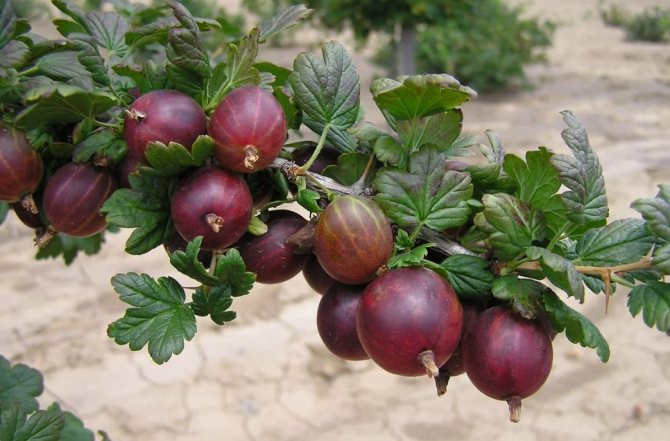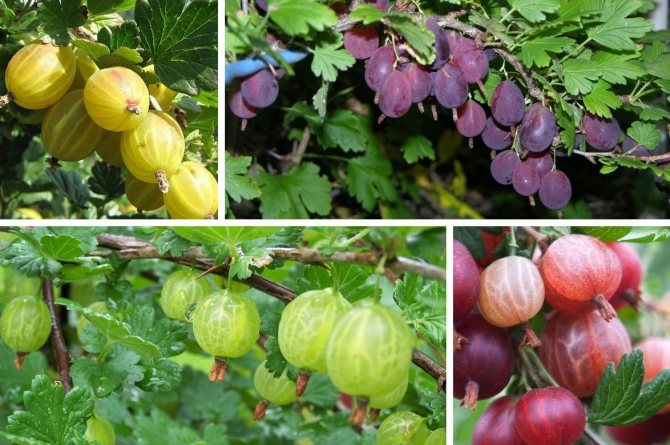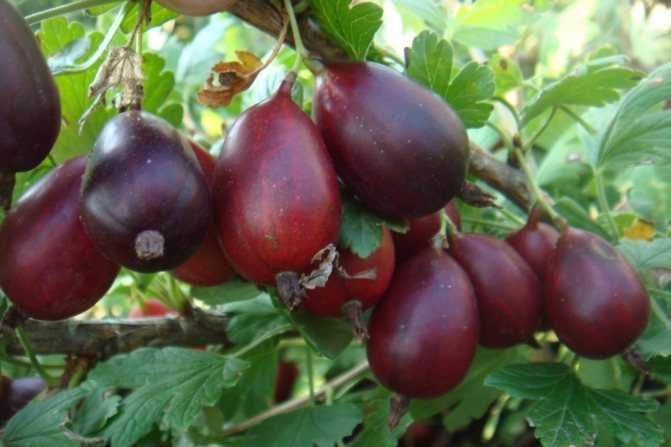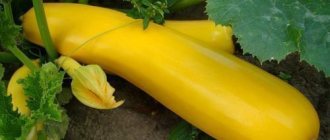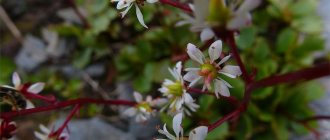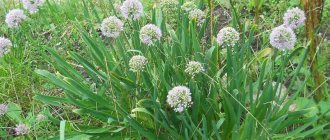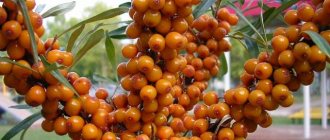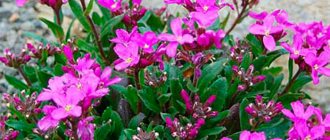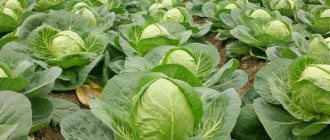Although the gooseberry is native to Northern Europe, it thrives in the Russian climate and is a pleasure to grow. It is less fastidious than other fruit and berry bushes, fertile, and a variety of varieties will allow harvesting from late spring to autumn. Hybridization has improved the taste of the berries, and today nurseries offer only the best varieties of gooseberries, zoned for a particular region and region.
Indian gooseberry (emblica officinalis, or amla) with pale and impossibly bitter berries, which are mainly used for medicinal purposes.
Cultivars can be sweet or sour, with honey, creamy, emerald, cherry or brown fruits, in all shapes and sizes. Dessert fresh berries will serve as an excellent delicacy, sour, more suitable for cooking, preservation and wine tinctures.
A fully ripe dessert gooseberry variety is not inferior in juiciness to strawberries or grapes. Elastic, striped berries are a real treasure trove of nutrients.
Distribution and habitat
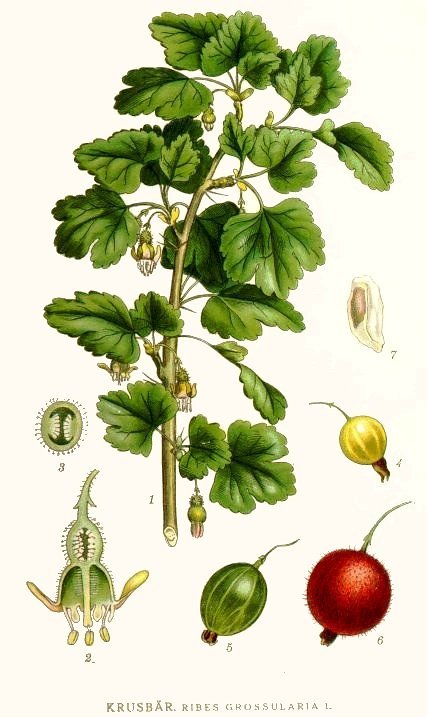
Botanical illustration from the book by K. A. M. Lindman Bilder ur Nordens Flora
, 1917-1926 1 - a branch of a flowering plant; 2 - cutaway flower; 3 - ovary in section; 4-6 - fruit at different stages of ripening; 7 - seed
Gooseberries are native to Western Europe and North Africa. As a wild plant, it is distributed in the Caucasus, Ukraine, Transcaucasia and Central Asia, Central and Southern Europe, North Africa and North America.
It grows among shrubs on rocky mountain slopes from the lower to the upper belt. It is widely planted in gardens, often runs wild and is introduced into the forests. In a feral state, it is found in Yaroslavl, Kostroma, Tver, Smolensk, Moscow, Vladimir, Kaluga, Ryazan, Tula, Tambov, Bryansk, Oryol, Samara, Saratov, Ulyanovsk regions. It is the ancestor of most cultivated varieties.
Classification of varieties by maturity
Gooseberries are classified according to their ripening times. Between early and late, a period of two months. It is recommended to plant shrubs with different periods, then within several months it will be possible to collect fruits.
Early
These varieties ripen in the middle of June. These include: Orlyonok, Yarovoy, Rodnik, Salut, Pink 2, Russian, Finnish.


Average ripeness
These include: Kolobok, Pink-2, Hinnomaki Gelb, Pax, White Triumph, Krasnoslavyansky, Moscow Red, Prune.
Late
Shrubs of these varieties ripen in the second half of August. These include: Russian, Malachite, Sadko, Smena, Date, Northern Captain, Serenada, Chernomor.
Botanical description
Common gooseberry is a small shrub up to 1-1.2 m high, with dark gray or dark brown peeling bark. The branches are tripartite, less often simple thorns of leaf origin. Young shoots are cylindrical, grayish, planted with thin needle-like thorns and small black dots. Leaf scar with three traces. The buds are brown, covered with numerous red scales, with pubescent white hairs along the edge. The buds sit in the axils of thorns (thorns) or above tripartite thorns.
Leaves are petiolate, round or heart-ovate, up to 6 cm long, short-pubescent and dull.Leaf blade with three to five lobes and a blunt toothed edge.
The flowers are bisexual, greenish or reddish, single or two or three in the leaf axils. Hypanthium, like sepals, pubescent. Blooms in May.
Flower formula: ∗ K (5) C 5 A 5 G (2 ¯) {\ displaystyle \ ast K _ {(5)} \; C_ {5} \; A_ {5} \; G _ {({\ overline {2 }})}} [6].
Fruits are berries, oval or almost spherical, up to 12 mm long (sometimes up to 30-40 mm), glabrous or coarsely bristly, with well-visible veins. Green, yellow, or purple. Ripen in June - August.
| Flower, leaf and fruit close up |
Freeze-Resistant Gooseberry Varieties
This indicator is important when making plant selection. The development of the shrub, its yield and taste characteristics of the fruits depend on the growing conditions.
Krasnoslavyansky
The shrub is characterized by low height, light spreading, the crown is relatively thin, the branches contain thorns. The berries are large, with an average weight of 9 g, with a round shape. The color is bright, deep red. There is no edge on the skin. Gooseberry has a dessert flavor. After planting, it bears fruit in the 2nd season. At the height of cultivation, the productivity is 7.2 kg. Frost-resistant species, resistant to powdery mildew.
Consul
Another name is Senator. The shrub is ranked among low plants with a dense, branched crown; spines are partially absent on the shoots. Fruits are medium-large, their weight can reach 6 g, the color range ranges from light to maroon, closer to black. The skin of the berries is thin, therefore, the harvested crop does not tolerate transportation well.
There are few seeds in the pulp, which makes the fruit an excellent jam. The plant will calmly endure a drop in temperature to -36 ° C, obtained for cultivation in frosty regions. In the first seasons of cultivation, it is characterized by low productivity, up to 3 kg, but with each season this figure grows three times.
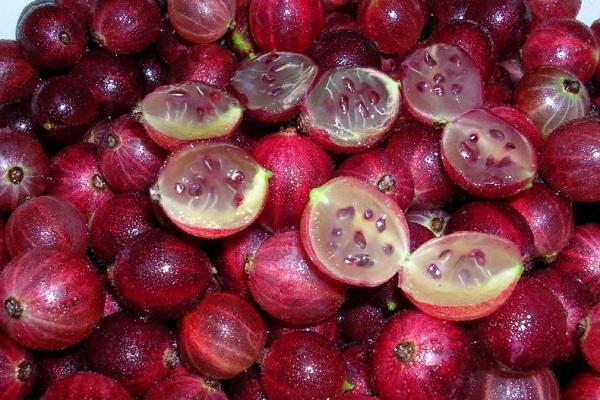

Beryl
Plant of medium height with little spreading. Spines are formed at the bottom of the shoots. Fruit weight reaches 8.6 g, have a spherical appearance, light green color. The flavor of berries is sweetish, highly appreciated by professionals. The shrub produces up to 9.3 kg of fruits, is characterized by the ability to withstand frost down to -36 ° C.
The plant is considered resistant to fruit rot. The variety has gained popularity due to its stable yield for almost 40 years.
Ural emerald
It is characterized by medium height and few spines. There is no edge on the berries, the average weight is up to 8.2 g. The name corresponds to the color of the berries, which have a dessert flavor and excellent aroma, with a juicy, dense pulp. The first harvest is done in the third year of cultivation. High-yielding species, yields up to 8.7 kg. Mid-early ripening period. Increased frost resistance, is able to withstand temperatures down to -37 ° C.
Belorussian
A bush with a small crown, the branches contain many sharp thorns. The fruits are characterized by a spherical appearance, weighing up to 8.2 g, with a bright greenish color, the most delicate, juicy pulp. They have a sweet taste, with a thin skin. Shrub of the old selection with increased frost resistance (up to -39 ° C). Medium ripening period. Life expectancy - up to 18 years, then it needs rejuvenation. Productivity - 8 kg.
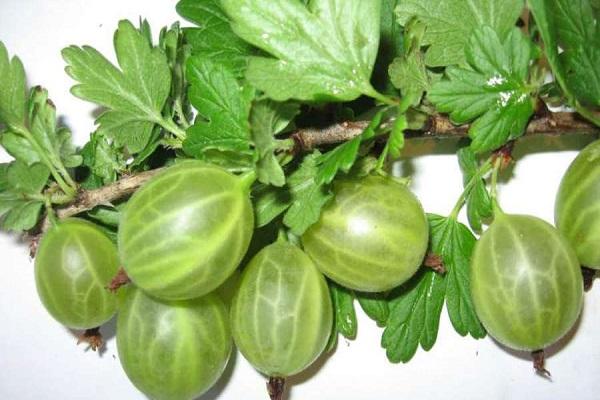

Economic value and application
Gooseberries contain up to 13.5% of sugars, most of which are easily digestible monosaccharides, up to 2% of free acids (citric, malic, etc.), more than 1% of pectin substances, vitamins (up to 54 mg%), (0.25 mg %), and. The berry ash contains a lot of phosphorus, copper, iron, potassium, sodium, calcium, magnesium [7].
The common gooseberry is one of the main berry bushes. The fruits are eaten fresh or used for making jams, jelly, confiture, compote, jelly, marmalade, filling for sweets and wine.For the winter, the berries are dried, pickled or crushed and covered with sugar (like currants) [7].
Currently, at least 1500 varieties of gooseberries are known, which are cultivated in all countries of temperate climates. The disadvantage of gooseberries is that they are often affected by sawflies, moths, aphids and other pests [7].
It is used in medicine. Gooseberry fruits are recommended for metabolic disorders and obesity. In folk medicine, they are used as a laxative, as well as a diuretic and choleretic [7].
Valued as a honey plant - the earliest of the berry bushes [8].
Growing features
Gooseberry is a rather unpretentious plant. But this does not mean that it will grow anywhere, in any light and without leaving at all.
Did you know? In terms of the percentage of iron content, gooseberries are ahead of even apples.
The right choice of seedlings
Choosing the right seedlings is half the success in getting a good gooseberry harvest:
- It is important to decide on the variety. In this case, one has to take into account not only the taste, color and size of the berries, but also the whimsicality of the variety to specific climatic conditions. If the gardener lives in a climatic zone with harsh winters, you need to choose frost-resistant varieties.
- When buying a seedling, you need to make sure that the roots are highly branched, fibrous and reach a length of 20-25 cm.
- The health and vitality of the seedling is also indicated by its division into 2-3 full-fledged shoots.


Disembarkation rules
Gooseberries are planted either in early spring, before bud break, or in late fall, after the leaves fall. This culture really does not like shaded places with high humidity. It is important that direct sunlight falls on the bush, but, at the same time, the site must be protected from strong winds.
The soil can be almost any, except for swampy or flooded areas. In constant humidity, the roots can start to rot. If the entire area is susceptible to flooding, you can make a small embankment for planting gooseberries.
Study the acidity of the soil needed for planting gooseberries.
In order for the seedling to root quickly and well, add a couple of buckets of compost or humus to the pit, as well as fertilizer of potash (wood ash) and phosphorus (phosphate rock and bone meal) composition according to the scheme 100 g per 1 m².
The planting depth of the seedling should be slightly deeper than it grew in the nursery, and slightly tilted. This will speed up its rooting and the appearance of new branches. After planting, you need to cut off the aerial part of the bush, leaving only 3-4 buds on each shoot.
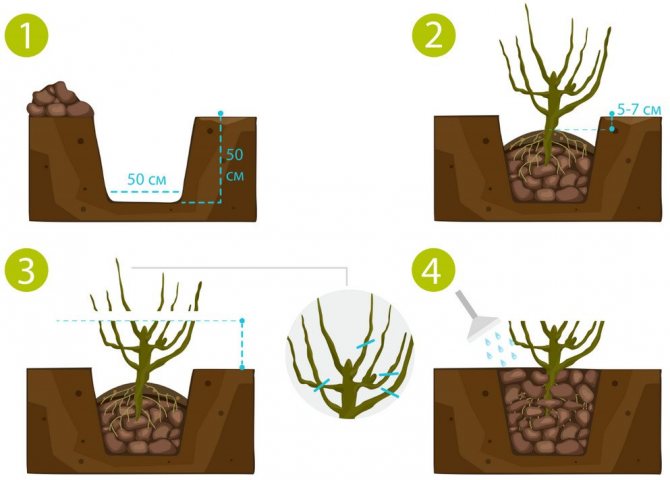

Bush care
Gooseberries need proper care, especially in the early years of the planting field. Excess or lack of moisture and light, cold winters with little snow and pests can be fatal for a young bush.
- The ground around the bushes should be looseslightly damp and weed-free. After weeding and loosening, you need to mulch the soil. This protects the roots from rotting or drying out.
- So that the bush is well ventilated and receives enough sunlight hanging down to the ground branches should be raised on supports... After the bush throws off the leaves, and snow accumulates under the branches, the branches must be removed from the supports. This will trap snow and warm the roots.
- If the winter has little snow, you need the maximum cover the bush with snow yourself. This is especially important in the first 2-3 years of his life, when the roots are still weak and the crown is not very wide.
- In the second half of summer, after fruiting the bush, gooseberries need feed... Bird droppings, mullein, or slurry work well.
- Gooseberries easily tolerate drought, but without sufficient watering they will not produce large berries. You need to water the bushes 3 times per season: when they bloom, when the berries ripen and after harvesting at the rate of 30 liters of water per bush. For watering, you need to dig a ditch around the perimeter of the crown, pour water into it and, after the water is absorbed, bury it.
- Gooseberry bushes need to be cut, removing, first of all, dry and weak shoots. Otherwise, the approach to each bush should be individual. On weakly branched shoots, you need to cut off the tops in order to increase the number of lateral shoots. Strongly branched shoots do not need to be cut off at all.


Do not forget that gooseberry is a bee-pollinated plant. Therefore, in order to obtain a good harvest, it is important to have bee hives nearby and to ensure free access of bees to the bushes.
How to grow a tree gooseberry?
With some care, it is possible to grow a standard bush that will look like a tree. For this, varieties with tall, strong shoots are used.
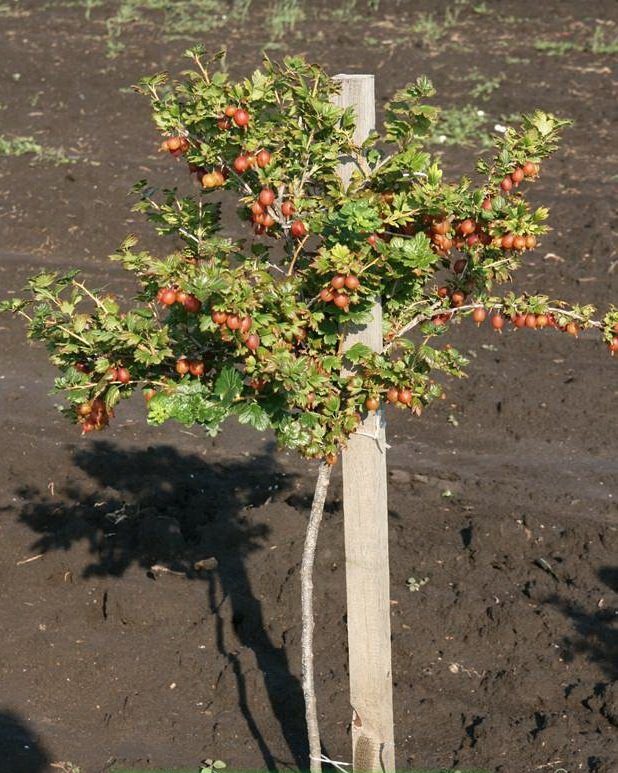

To get a tree-like plant, you need to determine the most powerful and direct shoot in the bush in early spring. All other root layers are cut out. The remaining barrel must be tied to a straight stick to prevent deflection and distortion.
As lateral processes appear, they need to be removed, leaving only a few at the very top. The procedure is repeated until the trunk is 80 cm high.
After that, you can start forming the crown. To do this, in early spring, the central shoot is cut by 1/5, and 4-5 buds are left on all the others. Such pruning provokes the appearance of additional lateral shoots.
If everything is done correctly, by 4-5 years a beautiful decorative tree will appear on the site, giving a good harvest.
Harvest
Depending on the variety, gooseberries can ripen from early July to late August.... Ripening is usually amicable, the entire harvest is done at the same time. From one bush, usually 5 to 8 kg of berries are harvested. The volume of the crop depends on the variety and care of the bush.
Important! Gooseberries do not crumble after ripening and remain on the bush for a very long time. Therefore, you can eat fresh gooseberries from the bush for a month.
Disease and pest control
Protecting gooseberry bushes from diseases and pests is perhaps the most important task. There are many chemicals that can kill insects, fungi and bacteria.
But you can do without them if you follow some rules and prevent infection of plants:
- In early April, before the snow completely melts, you need to pour boiling water over the bushes from a watering can with a fine spray. This procedure allows you to get rid of most of the pest larvae.


- Firebug larvae, the most dangerous pest for this plant, remain for the winter directly under the crown. To protect the plant from it, in the fall you need to carefully collect and burn all the fallen leaves and mulch. It is also advisable to loosen the top layer of the earth with the overturning of the formation.
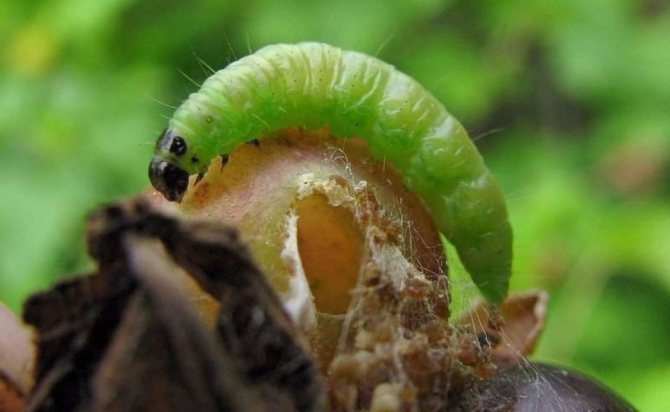

- To fight spider mite you need to spray the bushes with an infusion of wormwood. For this, half a bucket of chopped flowering wormwood is poured into 10 liters of water and left for a day. After a day, the infusion is boiled for 30 minutes. cool, drain and add 40 g of dissolved laundry soap.
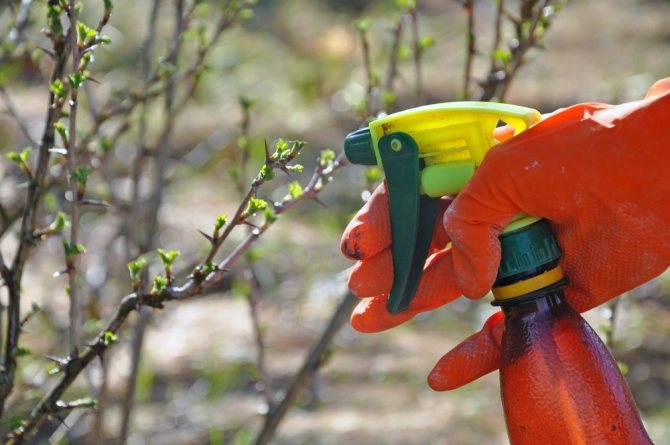

If the precautions were not taken in time and the gooseberries were exposed to insects, fungi or bacteria, you will have to resort to the help of insecticides and fungicides.
Important! When processing gooseberries, it is strictly forbidden to use preparations containing sulfur. This substance causes all leaves to fall prematurely.
Systematic position
Early classifications distinguished two kinds, Ribes
and
Grossularia
[9] (Gooseberry). In more widespread monographs, only one genus is recognized.
Ribes
[10]. Cross-resemblance between different types of currants and gooseberries ultimately led to the concept of a single genus [11]. As a result, the common gooseberry, often referred to as Grossularia reclinata (L.) Mill. [12], became Ribes uva-crispa.
Synonyms
- Grossularia glandulososetosa Opiz
- Grossularia hirsuta Mill.
- Grossularia intermedia opiz
- Grossularia pubescens Opiz
- Grossularia reclinata () Mill.
- Grossularia spinosa (Lam.) Rupr.
- Grossularia uva Scop. nom. illeg.
- Grossularia uva-crispa () Mill.
- Grossularia vulgaris Spach nom. illeg.
- Oxyacanthus sativus Chevall.
- Oxyacanthus uva-crispa () Chevall.
- Ribes aculeatum Salisb.
- Ribes caucasicum Adams ex Schult.
- Ribes crispum Dulac nom. illeg.
- Ribes dubium jacques
- Ribes grossularia
- Ribes grossularium St.-Lag.
- Ribes hybridum Besser
- Ribes reclinatum
- Ribes spinosum Lam.
De Janczewski (1907) split the genus Ribes
into 6 subgenera [13]:
Coreosma
,
Ribesia
,
Grossularia
,
Grossularioides
,
Parilla
,
Berisia
.
No thorns
Many gardeners are looking for thornless gooseberries for their plot. On such a plant, it is much more convenient to harvest, trim and process the trunk circle.
Consul
The Consul variety was created in the Urals; it has been present in the State Register since 1995 under the name Senator. Consul consists of straight branches, which perfectly cope with cold weather, immune to spheroteca. The thorns have no replacement shoots, the upper part and the base of the main shoots.
The degree of damage by sawfly and septoria is standard. Red berries weigh about 3.3 g and have a sweet and sour taste (4.7 points). The average yield of one bush is 3–6 kg.
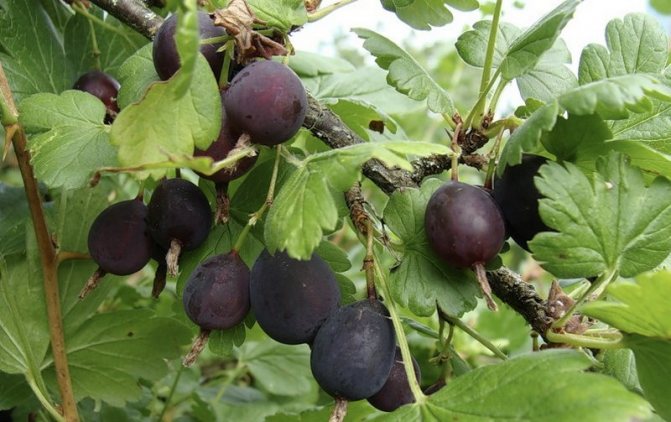

Eaglet
Although the Orlyonok variety is absent in the State Register, it has been grown in gardens since the 60s of the XX century and belongs to early maturing... According to the description of the author IV Popova, the plant has high winter hardiness and is resistant to spheroteca. Spreading bush, medium-sized, without thorns.
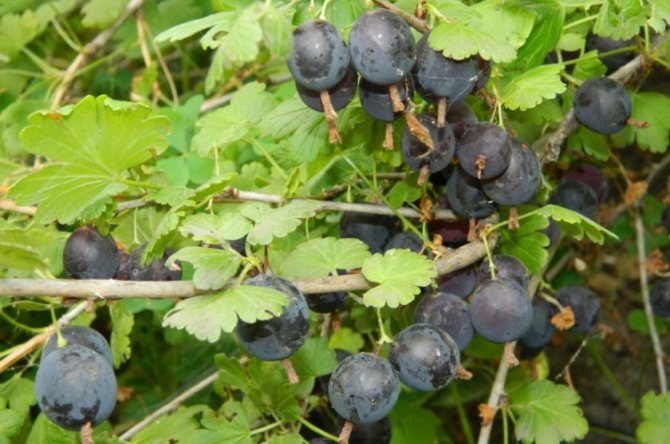

Black berries weigh 4 g and are characterized by a sweet and sour taste. The author attributes the Eaglet to table varieties, and carried out in the 80s. XX century tests showed a yield of about 6.6 kg per plant.
Grushenka
In the State Register, the variety Grushenka IV Popova is also absent, while it has long earned popularity among domestic gardeners. Grushenka has an average height, about 1 m, and high thickening. The bush tolerates frost and summer drought well, it is resistant to spheroteca, septoria and viruses.
The berries ripen in early August (medium late variety). Their color is described as dark purple, close to black. Average weight 4.3 g, sweet and sour taste with a score of 4.1-5 points. Up to 6 kg can be harvested from one bush.
Important! Do not use preparations with sulfur to feed gooseberries. This element causes leaf fall in the crop.
Varieties and hybrids
History
In England at the beginning of the 17th century, a number of varieties were created. Pansner's monograph in 1852 already described about 1000 varieties of gooseberries [14]. The first varieties of gooseberries were brought to America by settlers, but were not popular as they were severely affected by American powdery mildew (spheroteka). Presumably, the local American species were introduced into culture at the beginning of the 19th century, already in the middle of this century, a hybrid of European and American gooseberries was obtained.
Here is what Charles Darwin wrote about the domestication of gooseberries [4]:
| The most interesting aspect of gooseberry history is the constant increase in the fruit ... The wild gooseberry fruit is said to weigh about a quarter of an ounce, or 120 grains; around 1786 a gooseberry was exhibited weighing 240 grains, i.e. its weight has doubled; in 1817 the weight was 641 grains; until 1825 there was no increase, but this year the figure was 760 grains; in 1830 Teazer weighed 781 grains; in 1841 Wonderful 784 grains; in 1844 London weighed 852 grains, and the following year 880 grains; in 1852 in Steffordshire, the fruit of the same variety reached an amazing weight - 896 grains, i.e. a weight that was seven to eight times the weight of the wild fruit. |
The beginning of the gooseberry culture in Russia dates back to the 11th century. In the 19th century, the old domestic assortment was replaced by Western European varieties. The greatest achievements in gooseberry breeding were made in the 18-19th centuries. At the beginning of the 20th century, a spheroteka was brought to Russia from Ireland, and the development of gooseberry culture was suspended for a long time. In order to develop varieties resistant to spheroteca, combining resistance with a weak spine of shoots, breeders resorted to the use of distant hybridization - crossing large-fruited European gooseberry varieties with American species [15].
As a result of many years of work in the 1970s, German breeders obtained a hybrid of common gooseberries, spreading gooseberries and black currants: Ribes × nidigrolaria (Yoshta) = Ribes nigrum × Ribes divaricatum × Ribes uva-crispa
.
Some varieties
- 'Harlequin'
- 'Beryl'
- 'Strawberry'
- ‘Candy’
- 'Cooperator'
- ‘Favorite’
- ‘Pink 2’
- ‘Ural Pink’
Popular gooseberry varieties
Gooseberry species differ from each other: they are characterized by different ripening periods, fruit size and color.Some of them are allowed to be grown in all regions, some exclusively in southern climates. There are plants cultivated in the northern regions.
Bright
Shrub of medium spreading and vigor, dense. Spiking is common along the entire branch. Berries of medium size, up to 5.5 g, pinkish, gray-gray, slightly shaggy, sour-sweet, rounded. Winter-hardy, productive shrub.
Baltic
A compact spherical shrub, medium height. The branches are extremely thorny, containing smallish berries, up to 4 g in weight, of a greenish-light shade. It is characterized by a sour, pleasant aftertaste. A plant with increased resistance to anthracnose is recognized as winter-hardy.
Tender
Late variety, thornless, medium-sized shrub. The berries have a greenish color, sweet pulp with a pleasant aroma. Gooseberry weight 5 g. It is characterized by a yield of up to 5.8 kg per bush, high resistance to frost.
Affectionate
Berries with an average weight of 6.5 grams, with a rounded, even oval, shape, saturated red tone, covered with a shaggy bloom. Fruits with tasty pulp, with a peach aroma. A medium-sized shrub with weakly spiked shoots. Brings up to 7.5 kg annually. A highly winter-resistant plant that is resistant to powdery mildew.
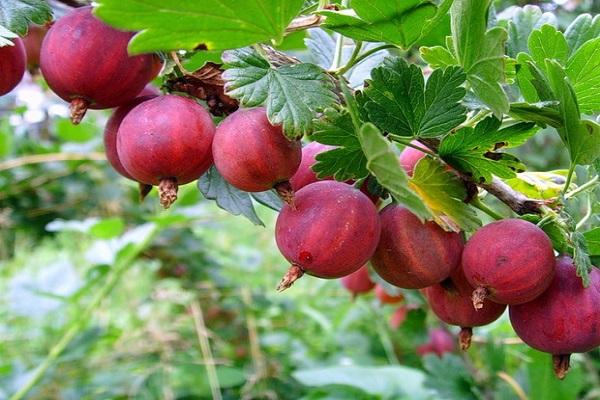

Freedonia
The plant is thornless, medium-sized. The fruit tastes like a mixture of strawberries and pineapple. The color of the fruit is red. It is characterized by immunity to powdery mildew.
Wine
The plant forms a sweet fruit, but requires timely harvesting, otherwise the fruit will turn sour. Hence the name. Overripe berries have the smell of alcohol. Rapid decay begins.
Lada
It is among the species that have good immune protection against common fungal infections. Late maturation. Shrubs of medium size with a wide crown. Fruits of pleasant sweetness, large, weighing from 5 to 8 g, increased productivity.
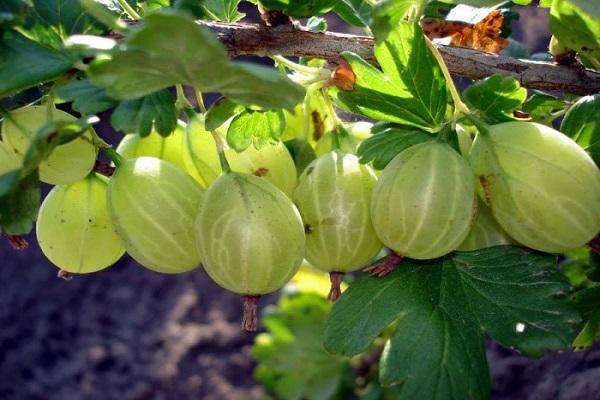

Royal
The gooseberry lives up to its name: the fruits are large, sweet, with a light green color. It is characterized by increased productivity. The branches contain infrequent thorns. Medium spreading plant.
Coral
The shrub is of an early ripening period, vigorous, not spreading, the branches are strongly spiked, with small fruits (up to 4.5 g). But they are with a sweet and juicy flesh of a green tone with a yellow tint, a little shaggy.
Peach
A medium-sized, medium-spreading winter-hardy shrub with large, amber-colored fruits that have a pleasant sweet-sour taste, stay on the stalks for a long time, without falling apart.
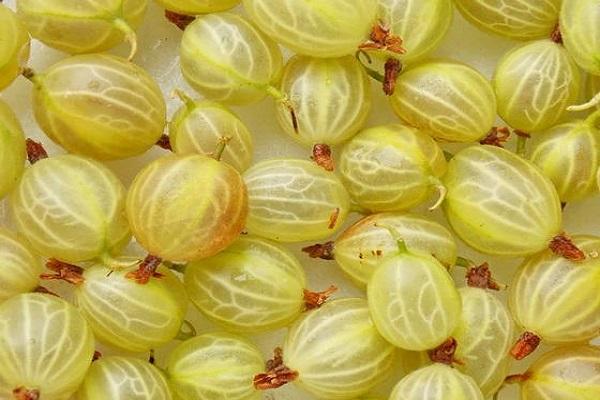

Phoenix
A medium-ripening shrub with medium frost resistance. Productivity - up to 4.6 kg per bush. Semi-sprawling shrub of medium height, demanding to care for. Fruits are oval-rounded, average weight up to 10 g.
Cardinal
The Commander is called in another way. The bush is of medium height and has no thorns. The berry is rounded, dark red, medium-sized (up to 7 g), has a thin skin. It is classified as a non-transportable variety.
Michurinets
Medium ripening period. The shrub is medium-sized and medium-spreading. The branches are thick, curved, the thorns are numerous. Fruits are medium in size, pear-like, dark reddish in color, with a rich waxy edge. The taste is sweet and sour. Average productivity - 5.3 kg.
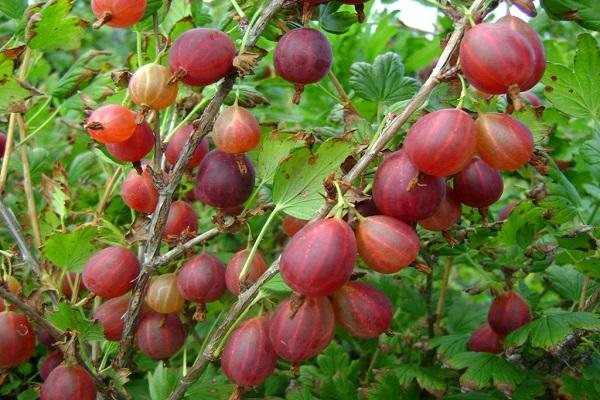

Nutmeg
Medium-sized gooseberries, up to 6.8 g, characterized by a red tint, oval. The pulp is sweetish, tender, with a sugary aroma. Medium ripening plant. Productivity ranges from 8.5 kg to 10.5 kg. A winter-hardy shrub that is immune to powdery mildew.
Video: planting, breeding, caring for gooseberries
Some people associate gooseberries with the taste of grapes, while others associate them with unpleasant crawling under thorny bushes. But the Chekhovian hero has a cozy village life.
You sit on the balcony, drink tea, and the ducks swim on the pond, it's so good ... and the gooseberries grow.
Anton Pavlovich ChekhovGooseberry story
So why not provide yourself with that comfort, including the joy of interacting with the thorny but sweet resident of the backyard!
Not all varieties are presented in the article. The choice from the crops of domestic and foreign selection is extremely diverse: both in the color of the fruits, and in the size of the berries, and in terms of ripening, and in terms of yield. You can choose a fruiting species for any region of Russia, Ukraine or Belarus, based on personal preferences and geoclimatic features. There would be a desire!
Tips for choosing a variety for different regions of Russia
The correct selection of the variety is of great importance, the growth rate is taken into account, otherwise the shrub will die, it will hurt and will not give the expected result. The choice takes into account: ripening period, resistance to temperature extremes and frost resistance.
Moscow region and central strip
The Moscow region is characterized by special weather indicators, since the winter is quite long here. Suitable for cultivation are varieties that are frost-resistant, adaptable to harsh conditions, able to withstand winds and have a strong root system.
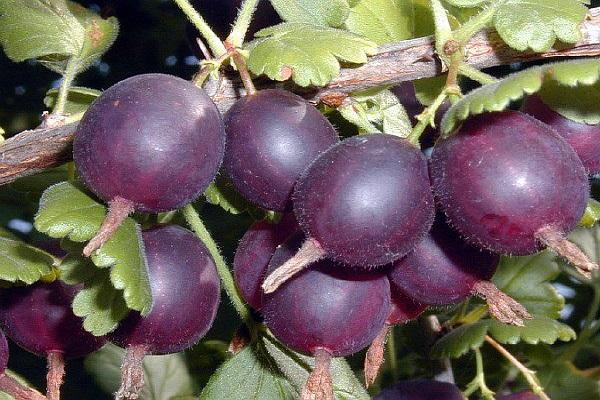

Grushenka
The plant is of medium height, with visually drooping branches, with practically no thorns. The fruits are small in size, the average weight is 5.4 g, similar to a pear, the color changes as the crop matures (from pale burgundy to juicy purple). Provides protection against common diseases.
Russian yellow
Belongs to the old varietal category, grown since the late 50s. A low shrub with a slight spreading, strewn with thorns. Forms pear-shaped fruits, yellowish color, weight index - up to 6.2 g. The presence of a delicate wax coating is visualized. The variety is characterized by persistent tolerance to sudden changes in temperature conditions, not long drought. Productivity averages 5-6.5 kg. Gives juicy berries with an excellent presentation. Gooseberries are considered unpretentious, undemanding to soil fertility.


Gingerbread man
The species is classified as medium-sized. The large fruit reaches a mass of up to 7.5 g. The type of berries is slightly elongated, the color is pale red. Taste indicators: sweetness with a slight sourness. It is resistant to anthracnose and powdery mildew. It is characterized by a period of medium ripening. Calmly tolerates temperature changes, moisture and a dry period.
Not taking into account the unfavorable cultivation conditions, it has good productivity.
Amber
A tall variety of shrubs, reaching 1.6 meters, spreading, a large number of thorns are observed on the branches. But this minus is compensated by delicious, beautiful, yellowish-orange fruits of an oblong appearance, weighing up to 5.7 g. It has an early ripening period, is characterized by increased productivity.
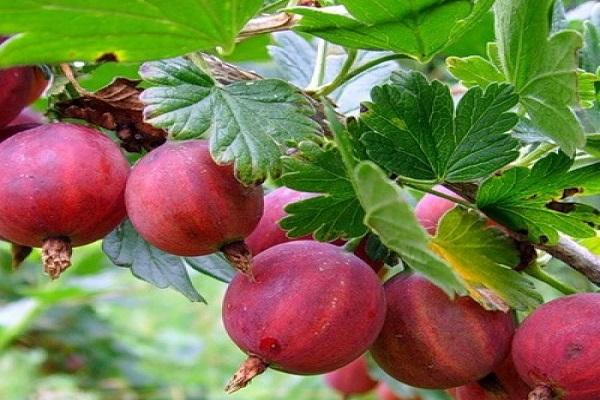

For the regions of Siberia
The best varieties for this area were bred by special institutes and experimental stations. Some of them are the best varieties of Soviet selection. Plants are characterized by increased winter hardiness, resistance to the common disease of anthracnose. Have an early fruiting period. The fruits are usually small. Varieties suitable for the area: Grossular, Beryl, Chelyabinsk Besshipny, Legin, Kooperator, Senator, Laskovy Spring, Ural Pink, Ural Emerald.
For the Urals
The selection of varieties is carried out taking into account the climatic indicators of the region. Not sprawling shrubs are chosen, with a powerful root system, undemanding to care, perfectly tolerating temperature changes, without thorns. They are hardy and give an early harvest. The most common: Russian yellow, African, Senator, Amber, Cardinal.
There are many varieties of varieties, which allows you to choose the desired plant, taking into account climatic characteristics and personal preferences.
What delicious can you cook
Gooseberries are considered especially useful for children and the elderly, since it is their organisms that are most sensitive to the influence of negative external factors. Benefit will be brought not only by preparations and fresh fruits, but also desserts made from fragrant berries. No less valuable properties are possessed by alcoholic extracts from gooseberries, as well as dessert alcoholic drinks - liqueur and wine, but they are only suitable for adults.
Raw jam
Features. This is an elementary way to harvest gooseberries in cooking. Raw jam is the basis for compotes, jams, sauces, and also just a very tasty addition to baked goods and tea.
Preparation
- 800 g of pure selected gooseberry berries are passed through a fine meat grinder twice, or interrupted until a uniform substance in a blender bowl.
- The resulting puree is poured with a kilogram of sugar, mixed thoroughly.
- Leave for several hours at room temperature. Stir periodically to dissolve sugar.
- After the sugar is completely dissolved, the jam is scattered into sterile jars, hermetically closing them.
- For better preservation, grated gooseberries should be stored in the refrigerator.
Compote
Features. The drink perfectly quenches thirst and also has cleansing properties. Very useful during the off-season. Helps to deal with the feeling of fullness in the stomach. To prepare gooseberry compote, the fruits are prepared in advance: they are sorted out, washed, each berry is pierced in several places.
Preparation
- In a saucepan, bring a liter of water to a boil, add 50 g of sugar.
- After boiling again, add gooseberries.
- Simmer over low heat for 15 minutes, then cool.
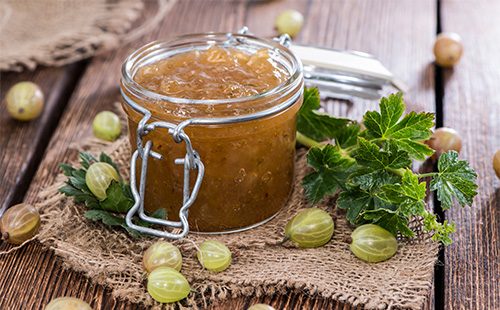

Pouring
Features. For cooking, it is worth selecting ripe, fragrant berries, then the final product will be more aromatic. The sweetness level of the gooseberry does not affect the taste, since sugar syrup is added to the liqueur.
Preparation
- Prepare the berries: sort out, wash, remove the stalks and dry sepals.
- Place a kilogram of fruit in a glass bottle, fill it with a liter of high-quality vodka.
- Kept in a dark place for two months.
- Syrup is boiled at the rate of a glass of sugar per glass of water, poured into the strained tincture, mixed thoroughly.
Wine
Features. Gooseberry wine is easy to make at home, but not so fast. Young wine can be drunk after the end of fermentation (after ten days), but in order to fully enjoy the fragrant drink, you should be patient.
Preparation
- 6 kg of processed gooseberries are minced in a meat grinder or using a blender.
- The resulting puree is poured into an enamel pan, mixed with 4 kg of sugar.
- After a couple of hours, add 6 liters of water. The mixture is placed in a warm place for four days. It is necessary to stir the wort every day, since the pulp can slow down the fermentation process.
- On the fourth day, the pulp is removed, the mixture is filtered into a clean container, which is placed in a warm place for another five days.
- At the end of the specified period, young wine is removed from the sediment into prepared clean bottles. Kept in a cool dark place for a month and a half.
The benefits of the common gooseberry are invaluable - the plant gives fruits that can heal many ailments. It is important to remember that the use of berries must be correct. In the presence of contraindications or reactions of individual sensitivity, the harm of the gooseberry can manifest itself as allergic rashes, as well as exacerbation of chronic diseases.
Fight disease
All major diseases that can threaten gooseberries are treated by spraying the bush with Bordeaux liquid. If the soil is affected, then it is watered with a solution of copper sulfate.The only disease that is difficult to get rid of is a mosaic (the growth of shoots stops, a mosaic pattern appears on the leaves). The affected bushes are usually disposed of. To protect gooseberries from most pests, branches, leaves and berries are regularly treated with insecticides.
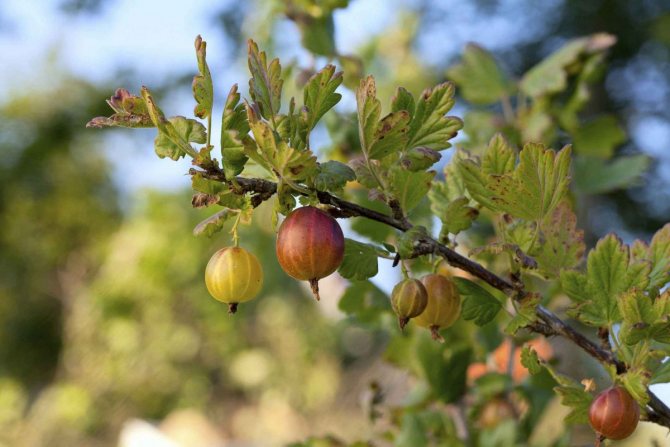

Diseases
The common gooseberry is a classic of the genre in the horticultural environment. It is in almost every summer cottage, but not everyone knows how to properly care for and reproduce it. The article above will help to replenish knowledge.
Medicinal properties of sweet fruits
Gooseberry is a real storehouse of components useful for the body. It has long been used to eliminate many diseases. The medicinal properties of gooseberries are as follows:
- laxative;
- diuretic;
- choleretic;
- antineoplastic;
- antiallergenic;
- hemostatic;
- fortifying.
Gooseberry is used to eliminate diseases of the cardiovascular system, in particular myocardial infarction, atherosclerosis, hypertension, varicose veins. Eating the fruits is necessary if you have problems with the liver and bladder.
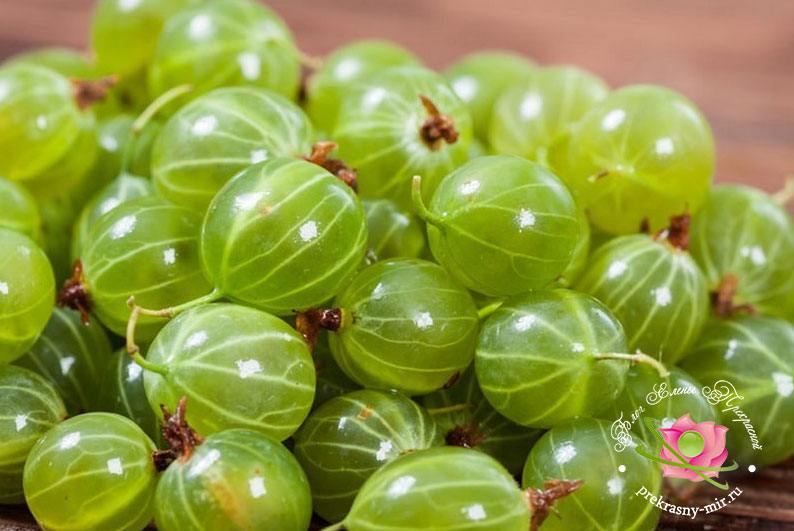

The healing properties of gooseberries
Gooseberry tea and decoction are widely used to eliminate colds, infectious diseases of the body and flu. For cooking, several berries are poured with strong boiling water and brewed. It is necessary to consume the fruits in the form of ordinary tea, 3 times a day.
The tincture is useful for inflammatory lesions of the body. A handful of gooseberries must be covered with sugar, and then poured with alcohol 2-3 cm over the berries. The resulting tincture is diluted 30% with water. It is taken to eliminate inflammation and rinse the mouth.
The use of gooseberry fruit drink is to normalize the protective functions of the immune system. Juice is considered the best vitamin and refreshing agent. The use of freshly squeezed and grated berries has a positive effect on the body. To normalize the digestive system, one tablespoon of fruit drink is enough 3 times a day.
Gooseberry is used in the treatment of many diseases. Its healing properties have been identified since ancient times. Since then, the plant has been at the heart of many folk recipes.
Use in cosmetology
How useful is gooseberry in cosmetology? Plant-based masks are widely used to restore the skin of the face, whole body and hair. Useful components allow you to stop the aging process, accelerate regeneration properties and saturate the skin with vitamins.
Regular use of gooseberries is a benefit for women that has been proven through years of research. Berry masks nourish, moisturize and nourish the skin of the face. They fight wrinkles, get rid of acne and pimples.
Gooseberry decoctions help in hair restoration. They make curls shiny and healthy. Medicinal use eliminates split ends.
Procurement and storage
The plant can be stored in any form. To preserve its beneficial properties, it is recommended to grind the fruits together with sugar or honey and pack them in glass jars. In this form, the berries are stored in the refrigerator for 6-12 months. How much candied fruit you can eat per day depends on the person's desire. For preventive and therapeutic purposes, one tablespoon is enough 3 times a day.
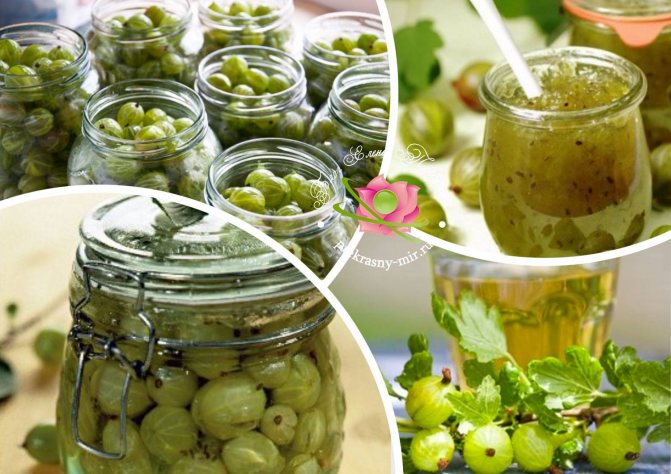

Gooseberry - preparations for the winter
You can save the berries unchanged. To do this, they are washed and sorted into special storage containers. In this form, the fruits retain their beneficial properties for 12 months.
The fruits of the plant have a pleasant sour taste. Due to their unique composition, they are widely used in cooking, medicine and cosmetology. Regular consumption of berries allows you to saturate the body with the necessary vitamins and minerals.
useful
An excerpt characterizing the Common gooseberry
- That's what I think. Austria has remained in a fool, and she is not used to it. And she will pay back.And she remained a fool because, firstly, the provinces were ruined (on dit, le Orthodox est terrible pour le pillage), [they say that the Orthodox is terrible in terms of looting,] the army is defeated, the capital is taken, and all this is pour les beaux yeux du [for the sake of beautiful eyes] Sardinian majesty. And that is why - entre nous, mon cher [between us, my dear] - I can hear with instinct that we are being deceived, I can hear with instinct relations with France and projects of peace, a secret peace, separately concluded. - It can't be! - said Prince Andrey, - that would be too disgusting. - Qui vivra verra, [We'll wait and see,] - said Bilibin, once again undoing the skin as a sign of the end of the conversation. When Prince Andrey came to the room prepared for him and lay down in clean linen on down jackets and fragrant heated pillows, he felt that the battle about which he had brought news was far, far away from him. The Prussian Union, the treason of Austria, Bonaparte's new triumph, the exit and parade, and the reception of Emperor Franz for tomorrow occupied him. He closed his eyes, but at the same instant a cannonade crackled in his ears, firing, the sound of the wheels of the carriage, and here again muskaters stretched out with a thread descend from the mountain, and the French shoot, and he feels his heart trembling, and he drives forward next Schmitt, and the bullets whistle merrily around him, and he experiences a sense of tenfold joy of life, which he has not experienced since childhood. He woke up ... "Yes, it was all! ..." he said, happily, childishly smiling to himself, and fell asleep in a strong, young sleep. The next day he woke up late. Renewing the impressions of the past, he remembered first of all that today it is necessary to introduce himself to Emperor Franz, he remembered the Minister of War, the courteous Austrian aide-de-camp, Bilibin and the conversation of yesterday evening. Dressed in full dress uniform, which he had not put on for a long time, for the trip to the palace, he, fresh, lively and handsome, with a tied hand, entered Bilibin's office. There were four gentlemen of the diplomatic corps in the office. Bolkonsky was familiar with Prince Ippolit Kuragin, who was the secretary of the embassy; Bilibin introduced him to others. The gentlemen who visited Bilibin, secular, young, rich and cheerful people, formed a separate circle both in Vienna and here, which Bilibin, who was the head of this circle, called ours, les nфtres. This circle, which consisted almost exclusively of diplomats, apparently had its own interests of high society, attitudes towards some women and the clerical side of the service, which had nothing to do with war and politics. These gentlemen, apparently, willingly, as their own (honor, which they did to few), took Prince Andrew into their circle. Out of courtesy, and as a subject to enter into the conversation, he was asked several questions about the army and the battle, and the conversation again disintegrated into inconsistent, funny jokes and gossip. “But it’s especially good,” one said, referring to the failure of a comrade diplomat, “it’s especially good that the Chancellor told him directly that his appointment to London was a promotion, and that he should look at it that way. Do you see his figure at the same time? ... - But what is worst of all, gentlemen, I give you Kuragin: a man in misfortune, and this is what this Don Juan, this awful man uses! Prince Hippolyte was lying in a Voltaire armchair with his legs over the handle. He laughed. - Parlez moi de ca, [Well, well, well,] - he said. - Oh, Don Juan! Oh snake! - voices were heard. “You don’t know, Bolkonsky,” Bilibin turned to Prince Andrei, “that all the horrors of the French army (I almost said the Russian army) are nothing in comparison with what this man did between women. - La femme est la compagne de l'homme, [A woman is a man's friend,] - said Prince Hippolytus and began to look into his lorgnette at his raised legs. Bilibin and ours burst out laughing, looking into Hippolytus's eyes. Prince Andrew saw that this Hippolytus, whom he (had to admit) was almost jealous of his wife, was a jester in this society.- No, I have to treat you to the Kuragin, - said Bilibin quietly to Bolkonsky. - He is charming when he talks about politics, you have to see this importance. He sat down with Hippolytus and, gathering his folds on his forehead, began a conversation with him about politics. Prince Andrew and the others surrounded both. - Le cabinet de Berlin ne peut pas exprimer un sentiment d'alliance, - began Hippolytus, looking significantly around everyone, - sans exprimer ... comme dans sa derieniere note ... vous comprenez ... vous comprenez ... et puis si sa Majeste l'Empereur ne deroge pas au principe de notre alliance ... [The Berlin Cabinet cannot express its opinion on the alliance without expressing ... as in its last note ... you understand ... you understand ... however, if His Majesty the Emperor does not change the essence of our union ...] - Attendez, je n 'ai pas fini ... - he said to Prince Andrey, grabbing his hand. - Je suppose que l'intervention sera plus forte que la non intervention. Et ... - He paused. - On ne pourra pas imputer a la fin de non recevoir notre Depeche du 28 November. Voila comment tout cela finira. [Wait, I haven't finished. I think that interference will be stronger than non-interference. And ... It is impossible to consider the matter as finished by not accepting our dispatch of November 28th. How will all this end.] And he let go of Bolkonsky's hand, indicating that now he had completely finished. - Demosthenes, je te reconnais au caillou que tu as cache dans ta bouche d'or! [Demosthenes, I recognize you by the stone that you hide in your golden lips!] - said Bilibin, whose cap of hair moved on his head with pleasure. They all laughed. Hippolytus laughed the loudest. He was evidently suffering, gasping for breath, but he could not resist the wild laughter stretching his always motionless face. - Well, here's what, gentlemen, - said Bilibin, - Bolkonsky is my guest in the house and here in Brunn, and I want to treat him, as much as I can, with all the joys of life here. If we were in Brunn it would be easy; but here, dans ce vilain trou morave [in this nasty Moravian hole], it is more difficult, and I ask all of you for help. Il faut lui faire les honneurs de Brunn. [I must show him to Brunn.] You take over the theater, I am society, you, Hippolytus, of course, women. - We must show him Amelie, lovely! - said one of ours, kissing the tips of his fingers. “In general, this bloodthirsty soldier,” said Bilibin, “should be turned to more humane views. “I’ll hardly take advantage of your hospitality, gentlemen, and now it’s time for me to go,” Bolkonsky said, glancing at his watch. - Where to? - To the emperor. - ABOUT! about! about! - Well, goodbye, Bolkonsky! Goodbye, prince; Come to dinner earlier, ”came the voices. - We take care of you. “Try to praise the order in the delivery of provisions and routes as much as possible when you talk to the emperor,” said Bilibin, escorting Bolkonsky to the front. - And I would like to praise, but I cannot, as long as I know, - Bolkonsky answered smiling. - Well, in general, talk as much as possible. His passion is audiences; but he himself does not like to speak and does not know how, as you will see. At the exit, Emperor Franz only gazed intently into the face of Prince Andrew, who was standing in the appointed place between the Austrian officers, and nodded to him with his long head. But after leaving yesterday's wing, the adjutant courteously conveyed to Bolkonsky the emperor's desire to give him an audience. Emperor Franz received him, standing in the middle of the room. Before starting the conversation, Prince Andrew was struck by the fact that the emperor seemed to be confused, not knowing what to say, and blushed. - Tell me, when did the battle begin? He asked hastily. Prince Andrew answered. This question was followed by other, equally simple questions: “Is Kutuzov healthy? how long ago did he leave Krems? " etc. The Emperor spoke with such an expression as if his whole purpose consisted only in asking a certain number of questions. The answers to these questions, as it was all too obvious, could not interest him. - At what time did the battle begin? The emperor asked. `` I can't tell your Majesty at what time the battle began from the front, but in Durenstein, where I was, the army launched an attack at 6 o'clock in the evening, '' said Bolkonsky, becoming animated and assuming in this case that he would be able to present the ready-made in his head a true description of everything that he knew and saw.But the emperor smiled and interrupted him: - How many miles? - Where and to where, Your Majesty? - From Durenstein to Krems? “Three and a half miles, your majesty. - Did the French leave the left bank? - As the scouts reported, the last ones crossed the rafts at night. - Is there enough forage in Krems? - The fodder was not delivered in that quantity ... The Emperor interrupted him. - At what time was General Schmitt killed? ... - At seven o'clock, I think. - At 7:00. Very sad! Very sad! The emperor said he was thanking and bowed. Prince Andrew went out and was immediately surrounded by courtiers from all sides. Affectionate eyes looked at him from all sides and gentle words were heard. Yesterday's aide-de-camp reproached him for not staying in the palace, and offered him his house. The Minister of War approached, congratulating him on the Order of Maria Theresa of the 3rd degree, which the emperor had bestowed on him. The Empress's chamberlain invited him to her Majesty. The Archduchess also wanted to see him. He did not know who to answer, and for a few seconds collected his thoughts. The Russian envoy took him by the shoulder, took him to the window and began to talk to him.
Gooseberry root system: structure


Gooseberry root system: structure
Let's look at some of the characteristics of the gooseberry root system.
The first characteristic feature of the gooseberry root system. If the gooseberry propagated using the vegetative method, then if it were cuttings or layering, then its root system would consist of small roots.
The second characteristic feature of the gooseberry root system.
These roots are called: adventitious, and they grow from root buds, usually not in the nodes.
The third characteristic feature of the gooseberry root system.
New roots appear on the adventitious clauses, usually in about nine to ten centimeters from the beginning of the first shoot.
The fourth characteristic feature of the gooseberry root system.
Subsequently, from the first adventitious roots, more and more new ones begin to grow, and so there are several orders of them.
The fifth characteristic feature of the gooseberry root system. Most of the roots, which provide the plant with the most nutrients, are root hairs, they are usually found on the roots from the fifth to eighth order.
The sixth characteristic feature of the gooseberry root system.
In an adult plant, all roots are of different ages and are located directly under the bush.
The seventh characteristic feature of the gooseberry root system.
As a rule, such roots are far away, do not go beyond the bush.
The eighth characteristic feature of the gooseberry root system.
If the soil is loose enough, then the roots can go down to a depth of one and a half meters.
The ninth characteristic feature of the gooseberry root system.
Usually the common part, the main part of the roots, is located at a distance of fifteen centimeters to half a meter.
The tenth characteristic feature of the gooseberry root system. Since new adventitious roots grow every year constantly, and new orders of roots are formed, the age of all adventitious roots cannot be the same.
Eleventh characteristic feature of the gooseberry root system.
The plant is durable precisely because its roots are constantly renewed.
The twelfth characteristic feature of the gooseberry root system.
A high yield can be obtained if you properly care for the bush and at twenty-five years.
Thirteenth characteristic feature of the gooseberry root system.
Proper care consists in properly loosening and cutting off excess shoots.
Gooseberry benefits and harm to the body
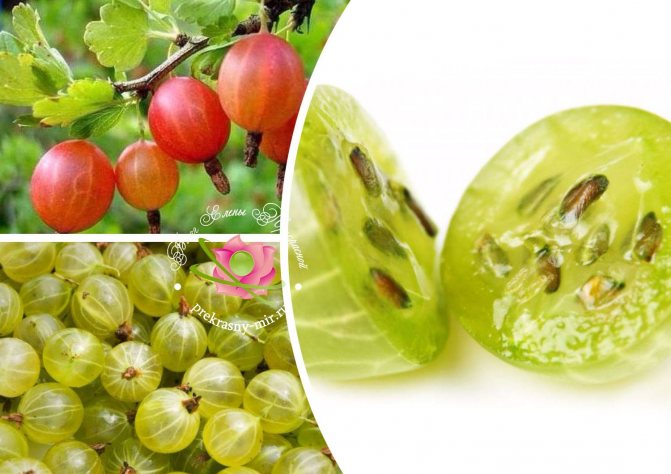

Useful properties of gooseberries for the human body
Gooseberry contains useful components that have a beneficial effect on the human body. Due to its unique composition, the plant has the following beneficial properties:
- antioxidant;
- anti-inflammatory;
- antineoplastic;
- anti-sclerotic;
- anti-aging;
- regenerative.
Beneficial properties for women are due to the composition of the berry. Regular use of the fruits allows you to normalize the general condition, remove toxins from the body and strengthen blood vessels. It is useful for those women who suffer from varicose veins. The berry helps to normalize hormones and improve the condition of the reproductive system. The use of gooseberries - the benefits for women are due to the presence of vitamins B and C.
The plant is useful for men as well. It helps prevent cardiovascular disease and atherosclerosis. Regular use lowers cholesterol levels in the body. Ripe fruits have a pronounced antitumor effect. The health benefits lie in the normalization of the functioning of the genitourinary system. For men, eating berries is the best prevention of prostatitis.
For children, the berry is no less useful. Eating sweet and nutritious fruits can improve brain performance. During the period of active growth of the child, he needs to consume the fruits of the plant. This will strengthen the skeletal system.
Recipes
Gooseberry dessert with pineapple and oranges
Ingredients:
- 500 g gooseberries;
- 125 ml of water;
- 150 g sugar;
- 4 eggs;
- 500 ml milk
- orange
- some wine
- almond cookies - 12 pcs.;
- half a pineapple.
Preparation:
- Rinse the gooseberries and cook for 10 minutes in water with sugar (100 g).
- Whisk the rest of the sugar with the eggs.
- Heat the milk and stirring continuously, combine with the egg mass. Heat over very low heat until thickened.
- Leave the cream to cool, break the cookies into pieces.
- Put gooseberries in glasses, a layer of cream on top, pieces of cookies. Drizzle with wine.
- Cut pineapple with orange into thin slices and decorate the dessert.
- Chill before serving and serve with ice cream.


Original gooseberry and garlic appetizer
Ingredients:
- 300 g of garlic;
- 2 tbsp. l. salt;
- 300 g gooseberries;
- 1 liter of water;
- 200 ml vinegar 9%;
- 2 tsp Sahara.
Preparation:
- Pour water into a saucepan, add salt and sugar and put on fire.
- Rinse the gooseberries and remove the tails, peel the garlic.
- Put whole cloves of garlic in a jar, put the berries on top.
- When the marinade boils, pour in the vinegar and pour the ingredients into the jar.
- Cover tightly and marinate for 2 weeks.
Harvesting
Gooseberry cultivars without thorns or with weakly spiked shoots are not yet found very often in household plots. Gardeners have to deal with hundreds of sharp thorns when harvesting fruits. You should always remember this precaution:
- Hide the skin under clothes;
- Protect hands with gloves;
- Do not make sudden rash movements in the thick of the bush.
A variety of devices come to the aid of summer residents: trays, combs, combines, fruit pickers of various types.
The timing of the collection corresponds to the tasks set. Berries for culinary processing and freezing are harvested a week before ripening. It should be elastic (keep its shape). The fruits collected in dry weather, without skin damage, are stored in a dark cool place for up to a week without spoilage.


The harvest
If summer is rainy, excess moisture can cause premature cracking of fruits and loss of crops. Under these conditions, gooseberries are harvested at the stage of technical maturity.
Berries have the highest taste characteristics at the stage of full consumer maturity. These fruits contain more vitamins and sugars, but are not stored, they lose their presentation during transportation. These berries are consumed fresh.
Gooseberry is an invaluable (in terms of the amount of nutrients) self-fertile, high-yielding, early-growing garden culture, which should be in every garden.
Gooseberry flower: structure
Consider the characteristic features of the structure of gooseberry inflorescences.
The first characteristic feature of the structural feature of gooseberry inflorescences.Gooseberry flowers are on the brushes on average on one cluster, maybe up to three flowers, they can also be single.
The second characteristic feature of the structural features of gooseberry inflorescences.
They resemble bells in appearance and have five sepals and five petals.
The third characteristic feature of the structural feature of gooseberry inflorescences.
As a rule, the petals are either greenish, or white, or with a red tint, there are five stamens inside the flower.
The fourth characteristic feature of the structural feature of gooseberry inflorescences.
The inferior ovary has many, seven buds.
The fifth characteristic feature of the structural feature of gooseberry inflorescences.
The pistil that is on top is considered two-part.
The sixth characteristic feature of the structural feature of gooseberry inflorescences. As mentioned above, the gooseberry is self-pollinated.
The seventh characteristic feature of the structural feature of gooseberry inflorescences.
Well, insects love to visit gooseberries, the way the flowers release certain nectar is for cross-pollination of the plants. The eighth characteristic feature of the structural trait of gooseberry inflorescences.
The yield will increase significantly if bees fly next to the gooseberry and the weather is mostly good during the season.
Gooseberry: culinary uses
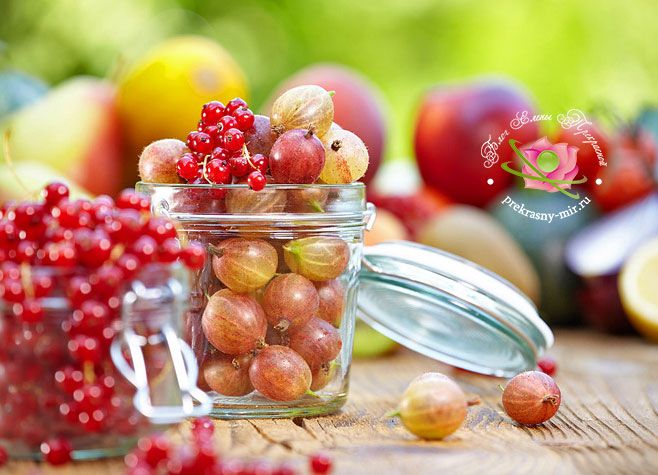

Gooseberry beneficial properties
How many berries can you eat per day? There are no particular restrictions on this issue. You can eat fruits both in pure form and in the basis of culinary dishes. The berries are used to prepare marmalade, preserves, compote and sauces for meat and fish products. The frozen product is suitable for pies and pies.
Contraindications
The benefits and harms to the body are directly related to the composition of the fruit. It is noteworthy that the components of the plant have a beneficial effect on the body, but at the same time they can aggravate the course of some diseases.
Contraindications to use: diabetes mellitus, renal diseases, allergic reactions and chronic enterocolitis. Berries are used with caution during pregnancy. When breastfeeding, it is recommended to eat fruits in small quantities.
Reproduction
Gooseberries can reproduce in a variety of ways:
- horizontal layering. To do this, young branches are taken, a neat cut is made on top of them, after which they bend to the ground and carefully dig into the holes. When new shoots grow above 10 cm, care begins for them, as for full-fledged plants;
- arcuate layering. Annual branches are laid horizontally in prepared grooves, pinned and covered with soil. The tip of the shoot is brought up in an arc, and in the fall it is separated from the main bush and transplanted;
- division of the bush. Used when transferring to a new location. The bush is cut into pieces, planting is done in pre-prepared holes;
- propagation by cuttings. The transplant technology differs depending on the season. In summer, green cuttings are taken, and lignified in autumn.

